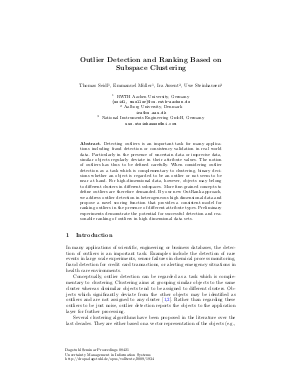Outlier detection and ranking based on subspace clustering
Authors Thomas Seidl, Emmanuel Müller, Ira Assent, Uwe Steinhausen
-
Part of:
Volume:
Dagstuhl Seminar Proceedings, Volume 8421
Part of: Series: Dagstuhl Seminar Proceedings (DagSemProc) - License:
 Creative Commons Attribution 4.0 International license
Creative Commons Attribution 4.0 International license
- Publication Date: 2009-03-24
File

PDF
DagSemProc.08421.10.pdf
- Filesize: 150 kB
- 4 pages
Document Identifiers
Subject Classification
Keywords
- Outlier detection
- outlier ranking
- subspace clustering
- data mining
Metrics
- Access Statistics
-
Total Accesses (updated on a weekly basis)
0PDF Downloads0Metadata Views
Abstract
Detecting outliers is an important task for many applications including fraud detection or consistency validation in real world data. Particularly in the presence of uncertain data or imprecise data, similar objects regularly deviate in their attribute values. The notion of outliers has thus to be defined carefully. When considering outlier detection as a task which is complementary to clustering, binary decisions whether an object is regarded to be an outlier or not seem to be near at hand. For high-dimensional data, however, objects may belong to different clusters in different subspaces. More fine-grained concepts to define outliers are therefore demanded. By our new OutRank approach, we address outlier detection in heterogeneous high dimensional data and propose a novel scoring function that provides a consistent model for ranking outliers in the presence of different attribute types. Preliminary experiments demonstrate the potential for successful detection and reasonable ranking of outliers in high dimensional data sets.
Cite As Get BibTex
Thomas Seidl, Emmanuel Müller, Ira Assent, and Uwe Steinhausen. Outlier detection and ranking based on subspace clustering. In Uncertainty Management in Information Systems. Dagstuhl Seminar Proceedings, Volume 8421, pp. 1-4, Schloss Dagstuhl – Leibniz-Zentrum für Informatik (2009)
https://doi.org/10.4230/DagSemProc.08421.10
BibTex
@InProceedings{seidl_et_al:DagSemProc.08421.10,
author = {Seidl, Thomas and M\"{u}ller, Emmanuel and Assent, Ira and Steinhausen, Uwe},
title = {{Outlier detection and ranking based on subspace clustering}},
booktitle = {Uncertainty Management in Information Systems},
pages = {1--4},
series = {Dagstuhl Seminar Proceedings (DagSemProc)},
ISSN = {1862-4405},
year = {2009},
volume = {8421},
editor = {Christoph Koch and Birgitta K\"{o}nig-Ries and Volker Markl and Maurice van Keulen},
publisher = {Schloss Dagstuhl -- Leibniz-Zentrum f{\"u}r Informatik},
address = {Dagstuhl, Germany},
URL = {https://drops.dagstuhl.de/entities/document/10.4230/DagSemProc.08421.10},
URN = {urn:nbn:de:0030-drops-19344},
doi = {10.4230/DagSemProc.08421.10},
annote = {Keywords: Outlier detection, outlier ranking, subspace clustering, data mining}
}
